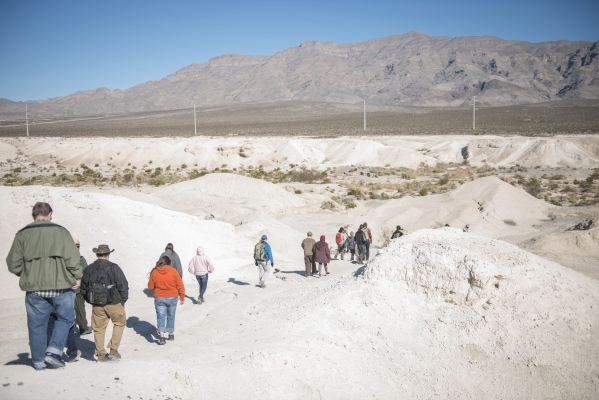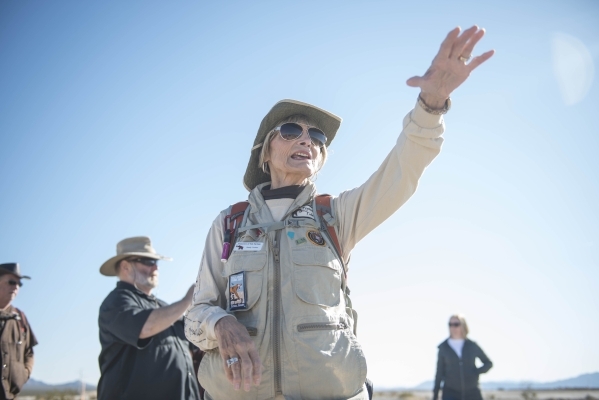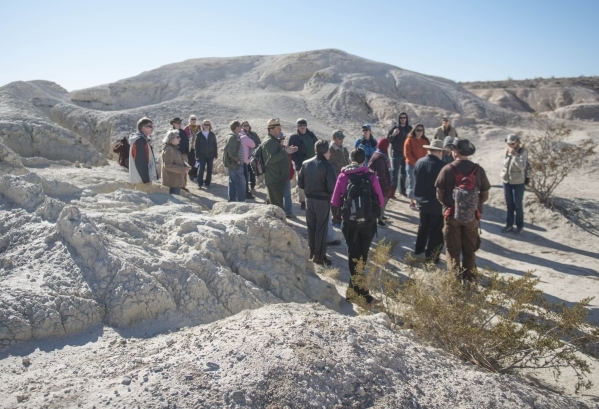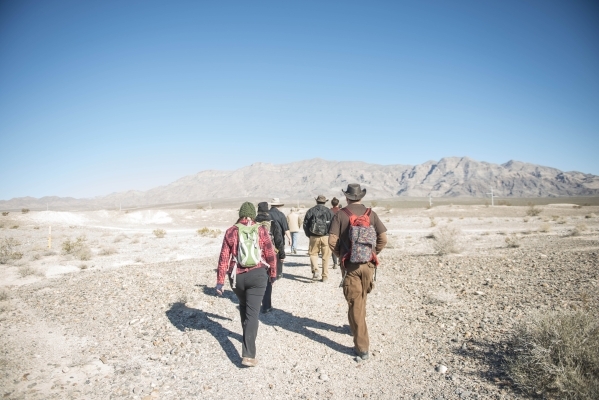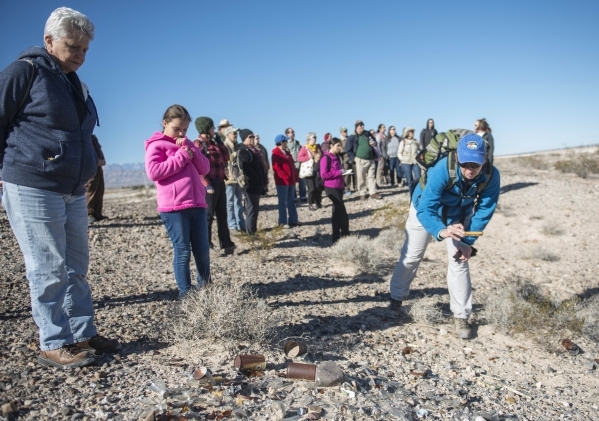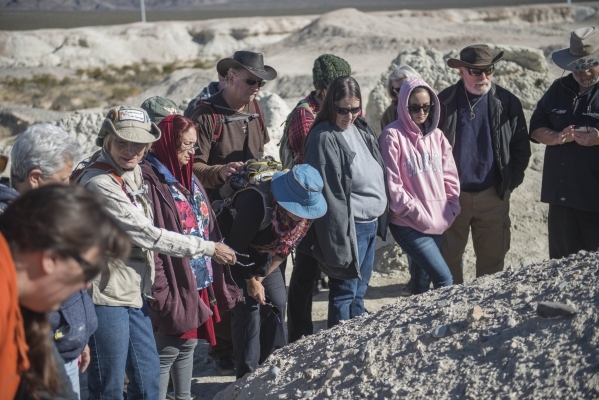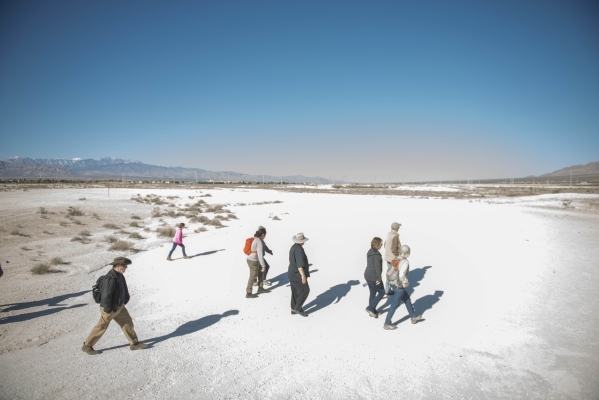Tours of Tule Springs Fossil Beds spotlight preservation efforts
It's hard to imagine that just past the fence surrounding Willie McCool Regional Park & Fly Field and underneath pieces of debris and broken glass is a part of the past between 7,000 to 250,000 years old.
On what first appears to be flat desert, scientists have been collecting the fossils of Columbian mammoths, camels and American lions, among other ice age creatures for years.
"When we first ventured out to protect this area, we didn't know exactly what we were doing, but we knew this area was too important to be built on," said Jill DeStefano, president and founder of Protectors of Tule Springs. "We wanted to preserve it for generations to come. This area is a living laboratory for our kids."
After moving to Sun City Aliante in July 2006, DeStefano and other concerned citizens formed the group to protect the fossils and prevent the area from being turned over for development by the Bureau of Land Management.
Their efforts helped create the Tule Springs Fossil Beds National Monument, which was established in December 2014.
The 22,630-acre monument begins in the northwest Las Vegas Valley just above Corn Creek and runs along the base of the Sheep Mountains to east of the Aliante master-planned community.
It is located in the Upper Las Vegas Wash and provides thousands of years of uninterrupted geologic history to be studied and documented by scientists.
It is the first national park specifically established to preserve ice age fossils, and as a result, it has put Las Vegas on the map for scientists as being one of the best Pleistocene (a time period spanning from 2.6 million to 11,700 years ago) paleontology sites, according to recently appointed superintendent Jon Burpee.
Exploring Nevada's backyard
On a sunny weekday in November, Burpee and real estate broker-turned-activist and founding member of Protectors of Tule Springs, Sandy Croteau, take a group of hikers back to the past.
"This is your backyard," Burpee says to the group. "This is your national park. What it becomes is ultimately up to you guys. It's a community-driven park."
It's difficult to spot fossils without a trained eye, but tour leaders easily point out splintered bones and tusks that resemble reddish-colored rocks and debris.
"Look! Here are some fossils," Croteau says to the group.
"How can you tell which ones are fossils and which ones are just rocks?" someone asks.
"They all have similar surface features and patterns," Croteau replies. "You learn what to look for after seeing them so many times."
Throughout the two-hour hike, tour guides are able to point out tusks, mammoth bones and miniature sea shells that provide proof of the extinct animals that once roamed the earth.
During the ice age, Croteau said the area was wetlands and home to animals such as the ground sloth, camel, bison, dire wolf, saber-toothed cat, llama and North American lion.
"The story here is one of exploration. That's what we want our visitors to do. We want them to explore," she said.
The tour also visited the trenches that were created in 1962 when the science of carbon-14 dating was tested during the "Big Dig." For four months that year, a multidisciplinary team of scientists documented and excavated fossils.
The trenches left behind — some more than a mile long — are now part of a U.S. National Register of Historic Places site of 1,000 acres.
It is also one of the last remaining areas where the Las Vegas buckwheat and bear poppy are found as well as the protected desert tortoise.
Future plans for Tule Springs
Although the national monument is in its infancy, a visitor's center detailing history and fossil displays, along with hiking trails and interpretive walks are planned in the future, according to Burpee.
Right now, his first priority is getting the word out about the relatively new monument.
All-terrain vehicle trails seen on the hiking tour are proof that some people aren't aware about the importance of the site.
"The park is open to the public, which is awesome and scary at the same time," Burpee said. "People can enter the monument on foot, but it needs to be treated in a special way. Visitors need to leave the fossils where they are because they're part of our heritage, and we want to preserve them for our great-grandchildren and their great-grandchildren."
Starting early next year, Burpee plans to develop a site stewards program to recruit and train volunteers to report destruction or vandalism of prehistoric and historic archaeological and paleontological sites.
In the meantime, those who are interested in seeing what scientists have been digging up in the area can head to the Nevada State Museum at the Springs Preserve, 309 S. Valley View Blvd.
The Protectors of Tule Springs also plan to schedule more hiking tours starting in early 2016. Information will be posted at tulespringslv.com.
"It's going to take time to develop the park," Burpee said. "It took about 200,000 years to create this fossil site; it's going to take us a few years to create the park's future."
Visit nps.gov/tusk/index.htm.
— To reach North View reporter Sandy Lopez, email slopez@viewnews.com or call 702-383-4686. Find her on Twitter: @JournalismSandy.
Tule Springs Fossil Beds National Monument
35 square miles
Stretches along U.S. Highway 95 north of Aliante and Centennial Hills to Creech Air Force Base near Indian Springs
Open only during daylight hours
No visitor center, facilities or parking areas
Vehicles permitted only on approved roads; no off-roading. Park on nearby public roads and enter the monument on foot.
Admission: free
nps.gov/tusk




